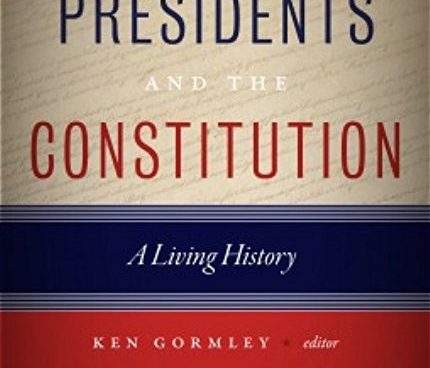Review: The Presidents and the Constitution: A Living History, by Ken Gormley, New York University Press, 2016

Donald Trump is not the first President to be involved in thorny constitutional issues. However, his Presidency may very well stem the tide or even reverse the trend toward the imperial presidency that began in the 19th Century and accelerated during the progressive era and later.
Since the Presidency of George Washington, it has been the Presidents themselves who have defined the powers delegated to them in Article 2 of the United States Constitution. They have pushed the limits and challenged the boundaries of the powers given to them by the framers in 1787. Sometimes they succeeded and sometimes the Supreme Court pushed back and held their actions unconstitutional.
With few exceptions, each President responded to the events and issues of their time by pushing and testing Presidential power. That power peaked and some would say became “imperial” during the Presidencies of George W. Bush and Barak Obama. However, each administration left its mark on how to interpret the boundaries of executive power. The current “imperial presidency” is the result of the history of the Presidency and the people who held the office from the beginning.
“The Presidents and the Constitution: A Living History” by Ken Gormley is the authoritative source for understanding the intersection between presidential history and the Constitution. This great book is filled with information that serves as a footnote to Article Two of the Constitution. It places the use of presidential powers in historical context and shows how the powers of the president and the Constitution evolved over time to the way we know it today.
Each chapter of the book not only features a different president, but is also written by a different author. Gromley delegates the task of analyzing each administration’s interpretation of presidential power to those most familiar with the subject. Authors range from historians to judges to journalists. Notable names include Richard Ellis, Gary Hart, Stanley Kutler, and Kenneth Starr.
While each chapter delves into the individual challenges faced by each president, the unifying themes are readily apparent. For instance, although the presidencies of George Washington and Barak Obama occurred centuries apart, both engaged in fierce Congress over the boundaries of executive power.
This book should be on everyone’s reading list. It is a must read for anyone interested in history or law and it is the essential footnote to Article 2 of the United States Constitution.
“Ken Gormley and 44 writers on all our presidents have connected the Constitutional dots brilliantly, demonstrating the immense concentration of power in the chief executive and the different, often contradictory, ways it has been used or misused,” Bob Woodward of The Washington Post wrote in his review. “The book is a class in Constitutional Law all by itself. In several crucial ways this is what the 2016 race for the White House is about—who has precisely what power, who shares it, how is it going to be exercised, and what, if any, are its limits.”
While each chapter is well written and researched, Gormley is the unifying presence behind all of the essays. A leading constitutional scholar, Gromley is the current President of Duquesne University. He previously served as the dean and a professor of constitutional law at Duquesne University School of Law.
As an author, Gromley is adept at bringing objectivity to controversial subjects, while also highlighting the human motivation behind significant historical events. He published Archibald Cox: Conscience of a Nation in 1997, which won the 1999 Bruce K. Gould Book Award for outstanding publication relating to the law. In 2010, Gormley published The Death of American Virtue: Clinton vs. Starr, a New York Times bestseller detailing the scandals that rocked Bill Clinton’s presidency.
The Presidents and the Constitution: A Living History is available on Amazon.com. The hardcover version is $36.22
